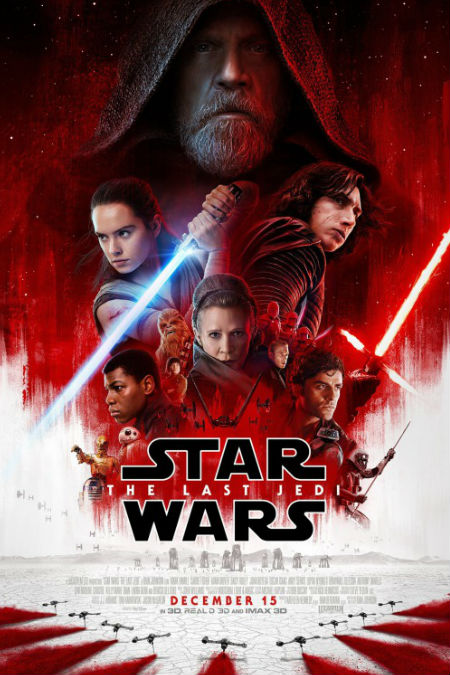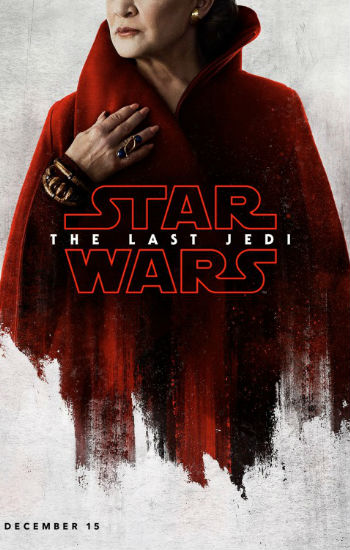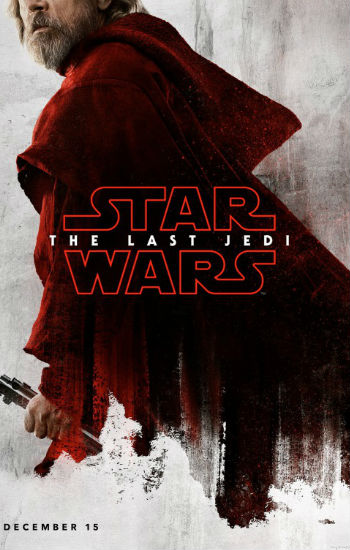
There comes a time in every franchise, even one as venerable and deeply-loved at George Lucas’s Star Wars when the old must give way to the new and the characters we know and love hand over, in this case at least, their light sabres and midi-chlorians and fly off into the distance in the Millenium Falcon (with or without Porgs).
For long standing fan it isn’t easy to watch, especially when you’re all too painfully aware that Carrie Fisher, who brought Princess Leia to life with wilful defiance for four decades, is sadly with us no more in real life, but if you’re a true fan of the franchise, you know that renewal is necessary and vital and only good, in the right hands at least, can come of it. (Those hands, for the record in the risk-averse world of Lucasfilm, do not include Chris Miller and Phil Lord or Colin Trevorrow who were fired over various creative differences from the Han Solo movie and Episode IX respectively.)
Having made your peace, you can enter the new instalment in the series, The Last Jedi for those of you playing at home, quietly confident that the old and the new will come together, one will depart, one will stay and the balance in the Force will be restored.
The only problem with this idyllic tale of franchise renewal is that the old and the new have ended up looking very much the same as each other.
Granted, thanks to a trip to Canto Bight, a new casino planet that is various James Bond scenes with an interplanetary edge and some social commentary thrown in for good measure, by ex-First Order stormtrooper Finn (John Boyega) and resistance techie Rose Tico (Kelly Marie Tran), we have an idea, a perfectly carved out, poetic idea of what that might look like.
But for all the talk of renewal and change, and the theme emerges often throughout The Last Jedi‘s narrative with even Luke Skywalker (Mark Hamill) noting, rather sagely as the new, more grammatically-inclined Jedi Master, that the time is up for the Jedi, the Dark Side of the Force, and pretty much everything and everyone we’ve known up to this point, not much really changes at all.

On the positive side of things, writer-director Rian Johnson, who so impressed the powers-that-be at Lucasfilm that he has been handed the next Star Wars trilogy to sculpt as he so desires (within limits no doubt), has not recreated The Empire Strikes Back as many thought he might after J. J. Abrams’ The Force Awakens ended up bearing more than a passing resemblance to A New Hope.
In a sprawling 152-minute saga, that likely could’ve benefited from some trimming given the number of times it seems stuck on repeat – witness the back-and-forth between Rey (Daisy Jones) and Luke on Ahch-To, the stark watery planet we glimpsed at the end of The Force Awakens which could’ve easily been shrunk down to a more briefly potent jostling of hearts and minds – we see the galaxy and the seemingly eternal struggle between the malevolent First Order and the riven by internal dissension Resistance taken on far darker, more realpolitik forms.
There’s talk of arms-dealing, the corruption of elites, the morality or otherwise of helping both sides to enrich yourself, mutiny, insurrection and many other politically real elements that Star Wars has hitherto hinted at but never wholly or openly embraced.
It likely reflects our far more cynical 21st century age, standing n stark comparison to Lucas’s decision in 1977 to invest his new sci-fi saga with the rampant’s joyous idealism of the postwar ’50s.
No such virtuous idealism here, with dark and light merging into more of a messy grey, which better conveys the murky moralities that make political entities, whether it’s in a galaxy far, far away or one very much closer to him.
This willingness to embrace the dark subtleties of power-wielding adds some captivating frisson and darkness, not to mention immersive drama to proceedings, a realness that Rogue One, last year’s standalone entry in the franchise, also possessed in spades.
Throw in the expected space battles and light sabre duels, none of which plays exactly as you might envisage to the ongoing narrative health of Star Wars as a whole, and some shock twists and turns, none of which can be detailed for fear of being consigned to spoiler hell, and you have one heck of a new entry in the franchise, one that brilliantly embraces the need for things to change, and change markedly.

Unfortunately, all this reinvention comes with a mish-mashy narrative that seems unable to completely divorce itself from what’s come before.
Hence while some things defy expectation, many others do not.
Take the final climactic battle on the old rebel base of Crait which looks a little too much like Hoth for comfort or the Rey and Luke encounters on Ahch-To, which do their best to invoke the spirit of Luke and Yoda on Dagobah but come off with considerably less power and import.
Both are attempts at something new, and succeed in part; even so, there is a sense that Star Wars, caught in an endless cycle of essentially telling the same story over and over – yes The Republic has fallen again and the tyrants, in the form of Supreme Leader Snoke (Andy Serkis) are in power; to lose one Republic is understandable, to lose a second is just careless – can’t quite extricate itself from a revolving plotline.
The nuances of political power that The Last Jedi quite blatantly embraces, don’t seem to have any sort of profound effect on much of the plot or characterisation with even the Force-based tussle between Rey and Kylo Ren (Adam Driver), which provides the one central compelling relationship of the film apart from Rey and Luke, feeling too much like a Luke/Darth Vader/Emperor retread.
The film is hobbled too by its attempts to add in some cute, wacky humour.
But while this works a treat in the Marvel universe, Star Wars, which has drawn its humour from character interplay rather than slapstick silliness (for the most part anyway), doesn’t benefit from Chewie (Joonas Suotamo) having adorably funny interactions with Ahch-To’s native birds, the merchandise-friendly Porgs, or Rey having clumsy, goofy run-ins with the Caretakers who tend to the last bastion of the Jedi.
They’re cute and funny moments in their own way and hardly a disastrous addition but they raise few to no laughs – the audience I was in remained almost universally unmoved by all those supposedly hilarious interludes – and add next to nothing to The Last Jedi.
Yes the film is a very good Star Wars tale, giving us the old (the meeting between Luke and Leia is as emotionally-resonant as you might expect) and the new (Rose Tico is a wonderful new addition to Resistance ranks alongside Finn and Poe Dameron (Oscar Isaac) and Vice Admiral Amilyn Holdo, played by Laura Dern), and it has some mighty powerful moments, but overall it lacks a coherent, robust narrative, or the ability to transport you away like other films in the franchise, suffering from too much fractured storytelling, a diminished sense of self, and a good but not great sense of where it wants to head next, a crucial deficiency you would think in a franchise hellbent on remaking itself for a whole new generation.